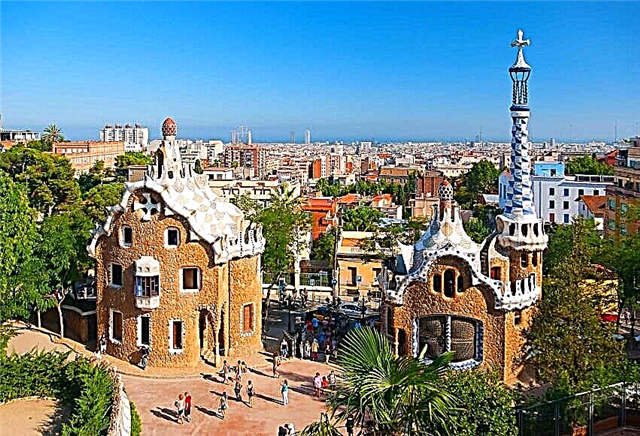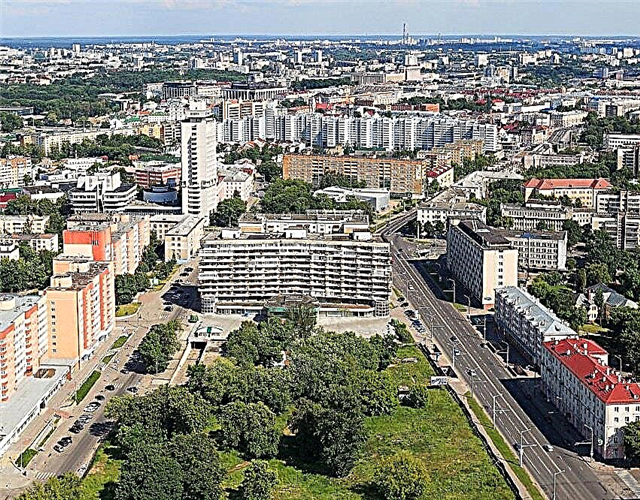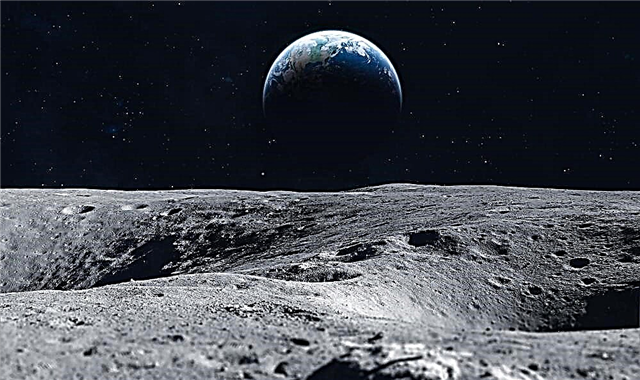On the African vegetation map, a quarter of the continent to the north is colored alarming red, indicating the minimum vegetation. The slightly smaller surrounding area is also marked with a pale purple that does not promise a riot of flora. Moreover, on the other side of the continent, at approximately the same latitude, there are a wide variety of landscapes. Why is a third of Africa occupied by an ever-increasing desert?

The question of why and when the Sahara appeared is not fully clear. It is unknown why the rivers suddenly went underground into a giant water reservoir. Scientists sin on climate change, human activities, and a combination of these reasons.
Sahara may seem like an interesting place. They say that some even fall in love with the austere beauty of this symphony of stones, sand and rare oases. But, I think, it is better to be interested in the largest desert on Earth and to admire its beauty, being somewhere, as the poet wrote, among the birches of the Middle Lane.
1. The territory of the Sahara, which is now estimated at 8 - 9 million km2, is constantly increasing. By the time you finish reading this material, the southern border of the desert will move by about 20 centimeters, and the area of the Sahara will increase by about 1,000 km2... This is slightly less than the area of Moscow within the new borders.
2. To date, there is not a single wild camel in the Sahara. Only domesticated individuals survived, originating from animals tamed by humans in the Arab lands - the Arabians brought camels here. In most of the Sahara, any significant number of camels for reproduction in the wild cannot survive.

3. The fauna of the Sahara is extremely poor. Formally, it includes, according to various estimates, from 50 to 100 species of mammals and up to 300 species of birds. However, many species are close to extinction, especially mammals. The biomass of animals is several kilograms per hectare, and in many areas less than 2 kg / ha.
4. The Sahara is often referred to as the Arabian phrase “ocean of sand” or “sea without water” because of the characteristic sandy landscapes with waves in the form of dunes. This image of the world's greatest desert is only partially true. Sandy areas cover about a quarter of the total area of the Sahara. Most of the territory is lifeless rocky or clay plateaus. Moreover, local residents consider the sandy desert to be the lesser evil. The rocky areas, which are called “hamada” - “barren” - are very difficult to overcome. Sharp black stones and pebbles, scattered in a chaotic manner in several layers, are a mortal enemy of both people moving on foot and camels. There are mountains in the Sahara. The highest of them, Amy-Kusi, is 3,145 meters high. This extinct volcano is located in the Republic of Chad.

Stony stretch of desert
5. The first known European to cross the Sahara from south to north was Rene Caye. It is known that Europeans visited North Africa earlier, in the 15th - 16th centuries, but the information provided by Anselm d'Isgier or Antonio Malfante is either scarce or contradictory. The Frenchman lived for quite a long time in the lands south of the Sahara, posing as an Egyptian captured by the French. In 1827, Kaye set off with a merchant caravan up the Niger River. His cherished desire was to see the city of Timbuktu. According to Kaye, it was supposed to be the richest and most beautiful city on Earth. On the way, the Frenchman fell ill with a fever, changed the caravan, and in April 1828 reached Timbuktu. Before him appeared a dirty village, consisting of adobe huts, of which there were also in those places from which he arrived. While waiting for the return caravan, Kaye learned that a few years earlier, some Englishman had visited Timbuktu, posing as an Arab. He was exposed and killed. The Frenchman was forced to join a camel caravan north to Rabat. So, unwillingly, Rene Kaye became a pioneer. However, he received his 10,000 francs from the Paris Geographical Society and the Order of the Legion of Honor. Kaye even became burgomaster in his hometown.

Rene Kaye. The collar of the Legion of Honor is visible on the left lapel
6. The Algerian city of Tamanrasset, located in the interior of the Sahara, suffers from floods quite regularly. In any other part of the world, residents of settlements located 2,000 km from the nearest sea coast at an altitude of 1,320 m should be the last to fear floods. Tamanrasset in 1922 (then it was the French Fort Laperrin) was almost completely washed away by a powerful wave. All the houses in that area are adobe, so a more or less powerful water stream quickly erodes them. Then 22 people died. It seems that only the dead French were counted by checking their lists. Similar floods claimed lives in 1957 and 1958 in Libya and Algeria. Tamanrasset survived two floods with human casualties already in the XXI century. After satellite radar studies, scientists discovered that a full-flowing river previously flowed under the current city, which, together with its tributaries, formed a branched system.

Tamanrasset
7. It is believed that the desert on the site of the Sahara began to appear around the 4th millennium BC. e. and gradually, over a couple of millennia, spread to the whole of North Africa. However, the presence of medieval maps, in which the territory of the Sahara is depicted as a completely blooming territory with rivers and cities, indicates that the disaster happened not so long ago and very quickly. Do not add credibility to the official version and arguments like that nomads, in order to get deep into Africa, cut down forests, systematically destroying vegetation. In modern Indonesia and Brazil, the jungle is cut down on an industrial scale using modern technology, but, of course, it is possible that it has not yet come to an environmental disaster. But how much forest could any nomads cut down? And when Europeans first reached the southern shore of Lake Chad at the end of the 19th century, they heard stories of old people about how their grandfathers were engaged in coastal piracy on ships on the lake. Now the depth of Lake Chad in most of its mirror does not exceed one and a half meters.

Map of 1500
8. In the Middle Ages, the meridional caravan route from the south to the north of the Sahara was most likely one of the busiest trade routes in the world. The same disappointing Rene Caye Timbuktu was the center of the trade in salt, which was brought in from the north, and gold, delivered from the south. Of course, as soon as the statehood in the countries adjacent to the caravan routes became stronger, local rulers wanted to control the gold-salt route. As a result, everyone went bankrupt, and the route from east to west became a busy direction. On it, the Tuaregs drove thousands of slaves to the Atlantic coast to be sent to America.

Caravan Route Map
9. 1967 saw the first Sahara race on beach yachts. Athletes from six countries marched from the Algerian city of Bechar to the capital of Mauritania, Nouakchott, on 12 yachts. True, in racing conditions, only half of the transition passed. The organizer of the race, Colonel Du Boucher, after several breakdowns, accidents and injuries, quite reasonably suggested that the participants go to the finish line all together in order to minimize the risks. The racers agreed, but it didn't get any easier. On the yachts, tires were constantly breaking through, there were no fewer breakdowns. Fortunately, Du Boucher proved to be an excellent organizer. The yachts were accompanied by an off-road vehicle escort with food, water and spare parts; the caravan was monitored from the air. The vanguard moved to the places of overnight stay, preparing everything for the night. And the finish of the race (or cruise?) In Nouakchott was a real triumph. Modern ships of the desert were greeted with all due honors by a crowd of thousands.

10. From 1978 to 2009 in December - January the engines of hundreds of cars and motorcycles roared in the Sahara - the world's largest rally-rail “Paris-Dakar” was held. The race was the most prestigious fortune for motorcycle, car and truck drivers. In 2008, due to terrorist threats in Mauritania, the race was canceled, and since 2009 it has been held elsewhere. Nevertheless, the roar of engines from the Sahara has not gone away - the Africa Eco Race runs along the track of the old race every year. If we talk about the winners, then in the class of trucks the Russian KAMAZ trucks are the invariable favorites. Their drivers have won the overall race score 16 times - exactly the same number as the representatives of all other countries combined.

11. The Sahara has large oil and gas fields. If you look at the political map of this region, you will notice that most of the state borders run in a straight line, either along the meridians, or “from point A to point B”. Only the border between Algeria and Libya stands out for its brokenness. There it also passed along the meridian, and the French, who found oil, twisted it. More precisely, a Frenchman. His name was Konrad Kilian. An adventurer by nature, Kilian spent many years in the Sahara. He was looking for the treasures of the disappeared states. Gradually, he became so accustomed to the locals that he agreed to become their leader in the fight against the Italians who owned Libya. He made his residence Tummo oasis, located on the territory of Libya. Kilian knew that there was an unchanged law, according to which every Frenchman who explored unknown lands at his own peril and risk becomes the plenipotentiary ambassador of his state. About this, and that in the vicinity of the oasis, he found numerous signs of the presence of oil, Kilian wrote to Paris. It was 1936, there was no time for plenipotentiary ambassadors somewhere in the middle of the Sahara. After the end of the Second World War, the letters fell into the hands of geologists. The oil was found, and its discoverer Kilian was unlucky - just a couple of months before the first fountain of “black gold” he committed suicide in a cheap hotel by hanging himself with pre-opened veins.

This is also Sahara
12. France was the main European colonial player in the Sahara for many years. It would seem that endless confrontations with nomadic tribes should have contributed to the development of adequate tactics for conducting military operations. During the conquest of the Berber and Tuareg tribes, the French constantly acted like a blind elephant that climbed into a china shop. For example, in 1899, geologist Georges Flamand asked the colonial administration for permission to investigate shale and sandstone in Tuareg areas. He received permission on condition to take the guard. When the Tuaregs saw this guard, they immediately took up arms. The French immediately called for reinforcements on duty behind the nearest dune, massacred the Tuaregs and captured the Ain-Salah oasis. Another tactic was demonstrated two years later. To capture the oases of Tuatha, the French gathered several thousand people and tens of thousands of camels. The expedition carried with them absolutely everything they needed. The oases were invaded without resistance, at the cost of a thousand casualties and half of the camels, whose bones littered the side of the road. The economy of the Saharan tribes, in which camels play a key role, was undermined, as were all hopes for a peaceful coexistence with the Tuaregs.
13. There are three types of nomadic tribes living in the Sahara. Semi-nomads live on plots of fertile land on the borders of the desert and engage in nomadic grazing during times free from agricultural work. The other two groups are united by the name of absolute nomads. Some of them wander along the routes laid down for centuries along with the change of seasons. Others change the way the camels are driven depending on where the rainfall has passed.

You can wander in different ways
14. The most difficult natural conditions make the inhabitants of the Sahara, even in the oases, work with their last strength and show ingenuity in the confrontation with the desert. For example, in the Sufa oasis, due to the absence of any building materials, except for gypsum, houses are built very small - a large gypsum domed roof cannot withstand its own weight. Palm trees in this oasis are grown in craters 5 - 6 meters deep. Due to the geological features, it is impossible to raise the water in the well to ground level, so the Sufa oasis is surrounded by thousands of craters. The inhabitants are provided with daily Sisyphean labor - it is necessary to free the funnels from the sand, which is constantly applied by the wind.
15. The Trans-Sahara Railway runs across the Sahara from south to north. The resounding name denotes 4,500 kilometers of road of varying degrees of quality, passing from the Algerian capital to the capital of Nigeria, Lagos. It was built in 1960 - 1970, and since then it has only been patched up, no modernization has been carried out. On the territory of Niger (more than 400 km), the road is completely broken. But the main danger is not coverage. Visibility is almost always poor on the Trans-Saharan Railway. It is impossible to drive during the day because of the blinding sun and heat, and in the evening and in the morning the lack of illumination interferes - there is no backlight on the highway. In addition, sandstorms often occur, during which knowledgeable people recommend moving off the track further. Local drivers do not consider dust storms as a reason to stop, and can easily demolish a stationary car. It is clear that help will not come right away, to put it mildly.

Section of the Trans-Sahara Railway
16. Every year, about a thousand people volunteer to go to the Sahara to run. The Desert Marathon is held in Morocco for six days in April. During these days, participants run about 250 kilometers. The conditions are more than Spartan: the participants carry all the equipment and food for the period of the race. The organizers provide them with only 12 liters of water per day. At the same time, the availability of a set of rescue equipment is strictly controlled: a rocket launcher, a compass, etc. Over the 30-year history of the marathon, it has been repeatedly won by representatives of Russia: Andrei Derksen (3 times), Irina Petrova, Valentina Lyakhova and Natalya Sedykh.

Desert Marathon
17. In 1994, the participant of the "Desert Marathon" Italian Mauro Prosperi got into a sandstorm. With difficulty he found himself a stone for shelter. When the storm died down after 8 hours, the environment completely changed. Prosperi couldn't even remember where he came from. He walked, guided by the compass, until he came across a hut. There were bats there. They helped the Italian to hold out for a while. Twice a rescue plane flew past, but they did not notice a flare or a fire. In desperation, Prosperi opened his veins, but the blood did not flow - it thickened from dehydration. He followed the compass again, and after a while came across a small oasis. A day later, Prosperi was lucky again - he went to the Tuareg camp. It turned out that he went in the wrong direction for more than 300 kilometers and came from Morocco to Algeria. It took the Italian two years to heal the consequences of a 10-day wandering in the Sahara.

Mauro Prosperi ran the Desert Marathon three more times
18. The Sahara has always been considered one of the most dangerous places for travelers. Loners and entire expeditions perished in the desert. But in the 21st century, the situation has become simply catastrophic. The beaten path to Europe is becoming the last for many refugees from Central African countries. Situations with dozens of dead look standard. Dozens of people are transported by two buses or trucks. Somewhere in the middle of the desert, one of the vehicles breaks down. Both drivers in the surviving car go for spare parts and disappear. People wait for several days, losing strength in the heat. When they try to get to help on foot, few have enough strength to get there. And, of course, women and children are the first to die.
nineteen.On the eastern outskirts of the Sahara, in Mauritania, is Rishat - a geological formation, which is also called the "Eye of the Sahara". These are several regular concentric rings with a maximum diameter of 50 km. The size of the object is such that it can only be seen from space. The origin of Rishat is unknown, although science has found an explanation - this is the action of erosion in the process of lifting the earth's crust. At the same time, the uniqueness of such an action does not bother anyone. There are other hypotheses as well. The range is quite wide: a meteorite impact, volcanic activity or even Atlantis - supposedly, it was located here.

Richat from space
20. The size and climate of the Sahara has consistently served as a rationale for energy super-projects. Headlines like “N% of the Sahara can provide electricity to the entire planet” appear even in the serious press with enviable regularity. The land, they say, is still waste, there is a lot of sun, little cloud cover. Build yourself solar power plants of photovoltaic or thermal type, and get cheap electricity. Already created (and subsequently disintegrated) at least three concerns, allegedly ready to start implementing projects worth billions of dollars, and things are still there. There is only one answer - the economic crisis. All these concerns want government subsidies, and the governments of the rich countries have little money right now. For example, all the world's giants of the energy market have entered the Desertec concern. They calculated that it takes $ 400 billion to close 15% of the European market. Taking into account the abandonment of thermal and nuclear generation, the project looks tempting. But the EU and the governments did not even give credit guarantees. The Arab Spring arrived, and the project allegedly stalled for this reason. Obviously, even in close to ideal conditions of the Sahara, solar energy is unprofitable without budget subsidies.










